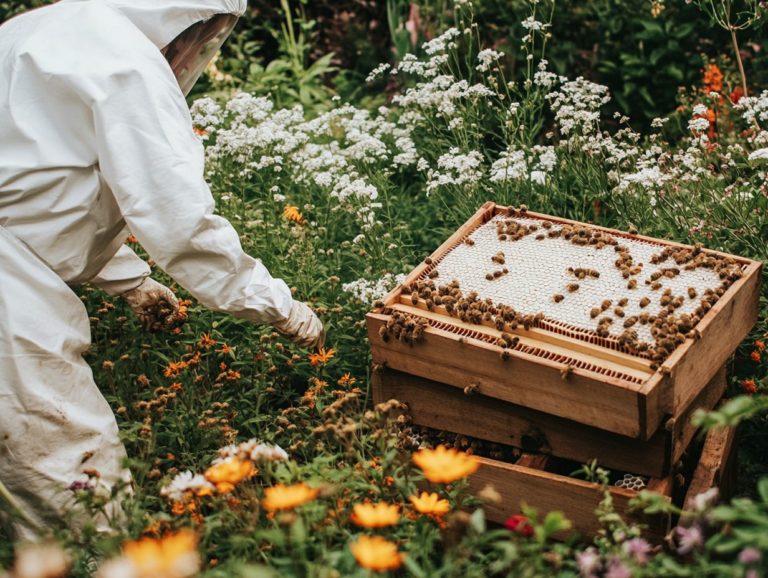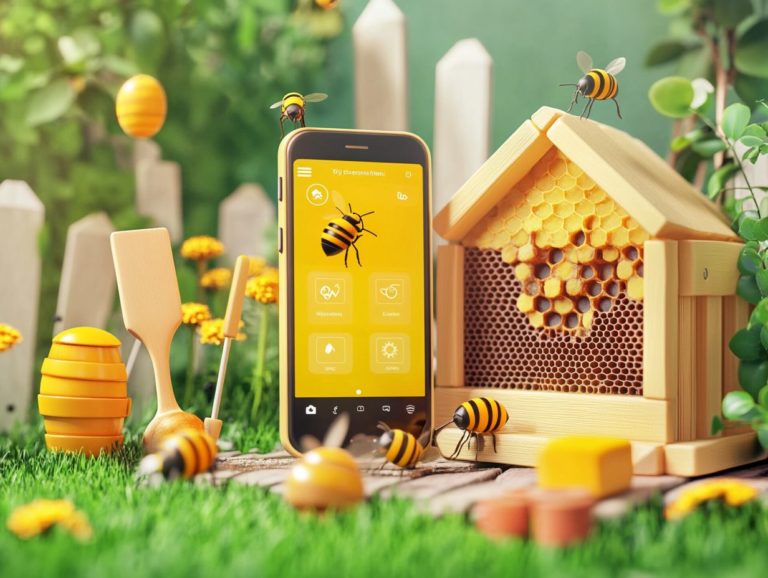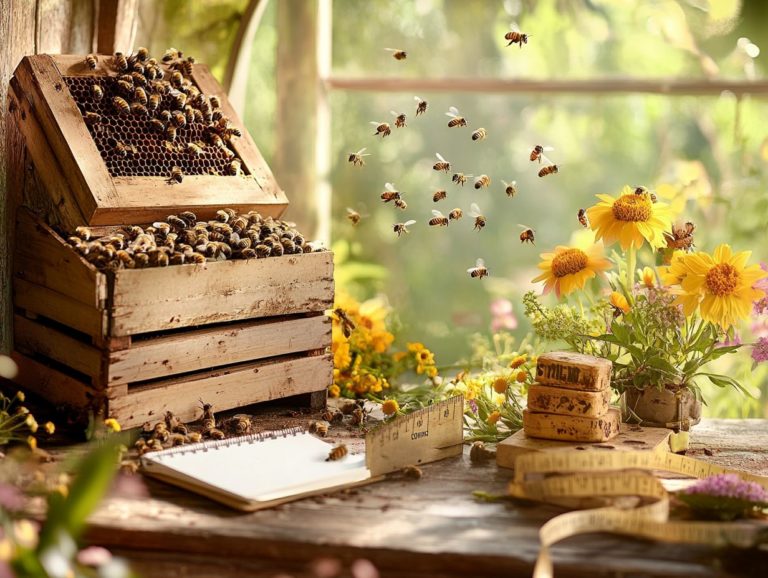How to Manage a Multi-Colony Apiary
In the realm of beekeeping, embracing a multi-colony apiary, including innovative systems like two-queen colonies, presents an intriguing and fulfilling method for hive management. This setup not only boosts honey production but also strengthens pollination efforts while reducing the risk of losing entire colonies.
However, managing multiple colonies does come with its own set of challenges, such as heightened labor demands and the potential for disease spread. This guide will walk you through the essentials of establishing and managing a multi-colony apiary, illuminating the myriad benefits while addressing the common hurdles you may encounter along your journey.
Contents
- Key Takeaways:
- What is a Multi-Colony Apiary?
- Why Would Someone Have a Multi-Colony Apiary?
- What are the Benefits of a Multi-Colony Apiary?
- How to Set Up a Multi-Colony Apiary?
- How to Manage Multiple Colonies in One Apiary?
- What Are the Challenges of Managing a Multi-Colony Apiary?
- Frequently Asked Questions
- 1. What is a multi-colony apiary and why is it important to manage it properly?
- 2. How often should I inspect my multi-colony apiary and what should I look for?
- 3. How can I prevent swarming in a multi-colony apiary?
- 4. How do I manage honey production in a multi-colony apiary?
- 5. How do I keep track of the different colonies in a multi-colony apiary?
- 6. What should I do if one of my colonies is struggling or fails?
Key Takeaways:
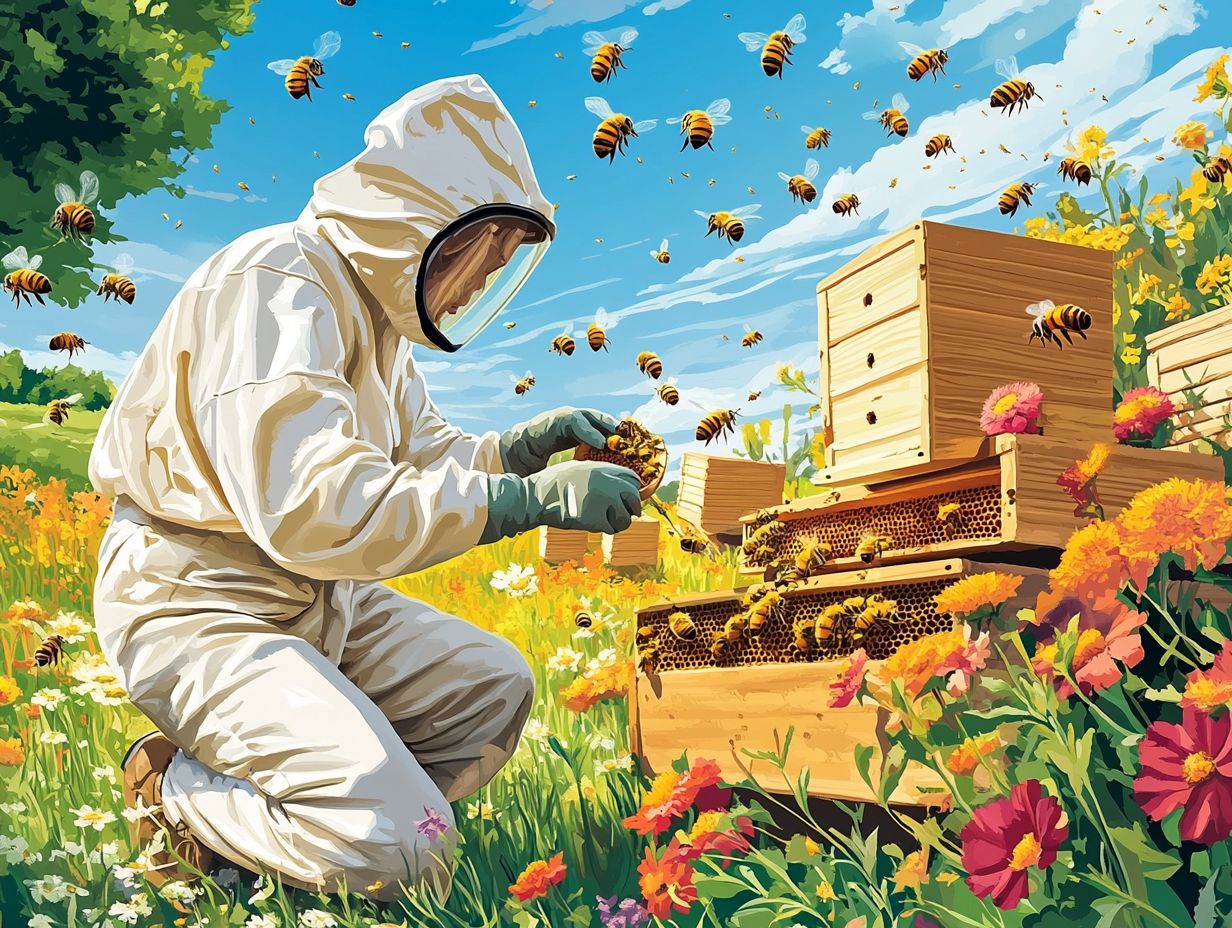
- Managing a multi-colony apiary can increase honey production and improve pollination while reducing the risk of colony loss. Beekeepers gain valuable insights into hive management.
- Proper setup of a multi-colony apiary includes choosing the right location, providing adequate space and ventilation, and installing protective fencing.
- Regular hive inspections, hive box rotation, drone brood removal, queen status checks, pest and disease monitoring, and providing adequate food and water are key to successfully managing multiple colonies in one apiary.
What is a Multi-Colony Apiary?
A multi-colony apiary is an advanced setup where you manage multiple bee colonies, including two-queen colonies, in a single location. This significantly enhances honey production and streamlines hive management.
This setup can use different hive types, such as the Langstroth hive, which is a widely used design for beekeeping, the Warre hive, and the Top Bar hive. Each offers distinct advantages that contribute to the overall efficiency and productivity of your apiary.
By leveraging these different hive styles, you can optimize your operations, maximizing honey flows and effectively managing your bee colonies across diverse environments.
Why Would Someone Have a Multi-Colony Apiary?
You ll find many exciting benefits in establishing a multi-colony apiary. For starters, you can significantly boost your honey production, make better use of resources, and effectively manage a diverse array of bee colonies.
Maintaining multiple colonies allows you to experiment with various hive types, like the Langstroth hive or Top Bar hive. This not only enhances your hive management practices but also promotes sustainability within your beekeeping operations.
Having multiple colonies acts as a safety net, protecting you against potential losses from pests or diseases. This way, you can ensure a steady flow of honey throughout the season.
What are the Benefits of a Multi-Colony Apiary?
A multi-colony apiary presents a wealth of benefits that can significantly elevate your beekeeping experience and productivity. You’ll enjoy increased honey production, improved pollination, and a minimized risk of colony loss.
By managing multiple colonies, you ll find yourself adapting your techniques and optimizing pest control measures, such as effectively tackling Varroa mites, a type of parasite that affects honey bees. This approach deepens your understanding of bee behaviors, including the intriguing phenomenon of drifting foragers.
This setup allows you to implement more effective hive management strategies. The diverse environment fostered by a multi-colony setup enhances pollination services for the surrounding crops, ultimately benefiting both your bees and the agricultural ecosystem at large, as seen in the Cheshire plain region s success with multi-colony setups.
1. Increased Honey Production
Establishing a multi-colony apiary offers you a remarkable advantage: the potential for increased honey production. With multiple colonies working in unison, you can maximize the collection of nectar from the surrounding flora.
Diverse foraging patterns and a higher number of bees in each colony significantly enhance the yield of hive products, ensuring a bountiful harvest during peak honey flow periods.
By strategically placing your colonies in varied locations that boast abundant floral resources, each colony can tap into different nectar sources, elevating overall foraging efficiency. It s essential to manage the health and vitality of these colonies.
Strong, thriving hives are far more capable of extensive foraging, which leads to greater honey production. Timing your honey extraction when the colonies are at their fullest will minimize stress on the bees and promote continuous productivity.
This holistic approach boosts your honey yield and contributes positively to the ecosystem by fostering effective pollination across diverse crops.
2. Improved Pollination
Improved pollination stands out as a key benefit of a multi-colony apiary. With a greater number of active bees buzzing about, the effectiveness of pollination services for nearby crops and plants is significantly heightened.
This increased bee activity not only boosts agricultural productivity but also reinforces the overall ecosystem by promoting biodiversity and fostering healthy plant growth.
When you maintain multiple colonies, bees become more adept at transferring pollen between flowers. This results in improved fruit set and seed production across a variety of crops.
This enhancement in pollination services is especially crucial for fruit-bearing plants and vegetables, which rely heavily on bee activity to achieve optimal yields.
Beyond the agricultural realm, this vibrant pollination helps wildflowers flourish, creating beautiful landscapes and sustaining entire ecosystems. By cultivating healthy bee populations within multi-colony apiaries, you can ensure that both cultivated and native plants enjoy improved reproductive success.
This approach nurtures resilient landscapes essential for preserving biodiversity. For example, members of the Olympia Beekeeping Association have reported significant benefits from this strategy.
3. Reduced Risk of Colony Loss
A multi-colony apiary significantly minimizes your risk of colony loss by enabling you to monitor and manage several colonies with greater efficiency. This proactive approach to hive management and Varroa management which includes techniques like drone brood removal and the use of a queen excluder allows you to take necessary measures before problems arise.
By diversifying your colonies, you ensure that if one faces challenges such as disease or pest infestations your other colonies can continue to flourish. This ultimately lowers your beekeeping costs and fosters sustainable practices.
You have the opportunity to implement targeted interventions across your apiary, making it easier to spot early signs of Varroa mite infestations and act swiftly.
Regular inspections and systematic data collection from all your colonies enable you to make informed decisions, allowing you to adjust treatment protocols before issues escalate into larger problems.
With a comprehensive strategy for Varroa management like using screened bottom boards or integrated pest management techniques, which involve using a combination of practices to control pests you can maintain healthier colonies overall.
This proactive risk management approach not only protects the wellbeing of each colony but also enhances honey production and pollination services, contributing positively to the local ecosystem.
How to Set Up a Multi-Colony Apiary?

Setting up a multi-colony apiary requires meticulous planning and execution to create the ideal conditions for your bees. This includes choosing the right location, ensuring ample space, and providing proper ventilation to maintain hive health.
By thoughtfully positioning your colonies, you can cultivate a flourishing environment that promotes robust bee populations and maximizes honey production.
Key factors to consider are the orientation of hives to capture sunlight effectively, the distance between colonies to reduce drifting foragers, and the accessibility of vital resources like nectar and water.
Are you ready to transform your beekeeping experience with a multi-colony setup?
1. Choosing the Right Location
Choosing the right location for your multi-colony apiary is crucial! It maximizes honey production and keeps your bee colonies thriving. The ideal site should be abundant in flowering plants that offer a generous supply of nectar. Additionally, it should provide protection from harsh weather and potential disturbances.
As you select the perfect spot for your apiary, consider factors such as accessibility, sunlight exposure, and proximity to water sources.
A good location not only encourages productive foraging but also creates a thriving environment for your bees. Sunlight is crucial for maintaining hive temperatures. Positioning your colonies in areas that receive morning sun can help them warm up quickly and start their day on the right note.
Furthermore, shelter your apiary location from strong winds and heavy rain, as these conditions can stress the bees and disrupt their foraging habits. Keeping an eye on nearby water sources is equally vital, as bees need water for feeding their colonies and regulating hive temperature.
When evaluating potential sites, take the time to observe local flora, such as nectar-producing plants, and weather patterns throughout the year. This careful observation will ensure a sustainable and healthy environment for your bees, setting the stage for a successful beekeeping venture.
2. Providing Adequate Space
When setting up a multi-colony apiary, providing adequate space is paramount. You can choose between a vertical configuration, like stacking multiple supers (a box used in beekeeping), in a Langstroth hive or a horizontal system, like the Top Bar hive, to accommodate your colonies efficiently.
Ensuring enough room for brood frames and honey production within each hive box will facilitate healthier colonies and better hive management.
Regularly evaluate the space needs of each colony, paying close attention to population dynamics and seasonal shifts. By observing your bees behavior and checking for adequate room in the brood chamber and brood box, you can prevent swarming and ensure your queen has the necessary space to lay her eggs.
Implementing a systematic rotation of brood frames and drone frames not only promotes the health of your colonies but also encourages the growth of young bees, which are crucial for nectar and pollen collection. Thoughtful planning in space allocation isn t just beneficial for the bees; it also enhances your honey yield, making it a critical element of effective beekeeping management.
3. Ensuring Proper Ventilation
Ensuring proper ventilation in your multi-colony apiary is essential for maintaining hive health and fostering robust bee populations. Inadequate airflow can lead to overheating and a heightened risk of diseases. Design your apiary layout to promote airflow between hives, allowing each colony to flourish without the detrimental effects of poor ventilation. As Ernie Schmidt of the Olympia Beekeeping Association suggests, proper hive placement is key.
A well-ventilated environment regulates temperature and controls humidity levels, which are vital for preventing the buildup of harmful mold and mildew within the hives. To optimize ventilation, position your hives to allow natural breezes to flow freely between them. Incorporating screened bottom boards can significantly enhance air circulation while also providing an escape route for pests, as recommended by experts like Paul Horton.
Ultimately, maintaining open entrances and ensuring ample space around each hive will further benefit your overall bee management. This encourages healthy foraging behavior and reduces stress within the colonies, supporting a thriving apiary. Apply these tips immediately to improve your apiary!
4. Installing Protective Fencing
Installing protective fencing around your multi-colony apiary is a crucial step in safeguarding your hives from various potential threats, including wildlife and unauthorized access. By creating a secure environment, you can minimize disturbances to your colonies and maintain effective hive management practices. This ultimately ensures the safety and productivity of your bees, as noted by Cheshire Plain beekeepers.
The need for such fencing becomes even more apparent when you consider the threats you might face as a beekeeper. Predators like bears, raccoons, and stray dogs can pose serious risks, potentially harming both your bees and your hives. The presence of unauthorized individuals can also disrupt colony behavior or lead to theft.
For installation, aim for best practices. Select sturdy materials that can withstand the elements. Ensure the fence is tall enough to deter entry and make it a habit to regularly monitor the perimeter for potential breaches. By implementing these protective measures, you enhance the security of your operation and cultivate a thriving environment for your bee populations.
How to Manage Multiple Colonies in One Apiary?
Effectively managing multiple colonies in one apiary demands an organized method that includes regular hive inspections, vigilant monitoring for pests and diseases, and ensuring ample food and water supplies are available for the bees.
Implementing a systematic management plan can safeguard the health and productivity of each colony, ultimately maximizing your honey production potential.
1. Regular Hive Inspections
Conducting regular hive inspections is essential for managing multiple colonies within your multi-colony apiary. This practice allows you to assess the overall health and productivity of your bees. During these inspections, focus on identifying signs of disease, checking the status of the queen, and ensuring that each two-queen colony or standard bee colony has sufficient space and resources to flourish.
Pay close attention to the presence of pests, such as Varroa mites (a type of pest that can harm bee colonies), and monitor food supplies, particularly during extreme weather conditions. An effective inspection requires you to don protective gear, utilize the right tools, and maintain a calm demeanor to keep stress levels low for the bees.
Approach your inspections methodically: begin with the outer frames and work your way inward. Examine each frame for brood patterns and honey stores. By adhering to these best practices, you ll not only protect the productivity of your hives but also contribute to a thriving ecosystem that supports the vital role bees play in pollination.
2. Rotating Hive Boxes
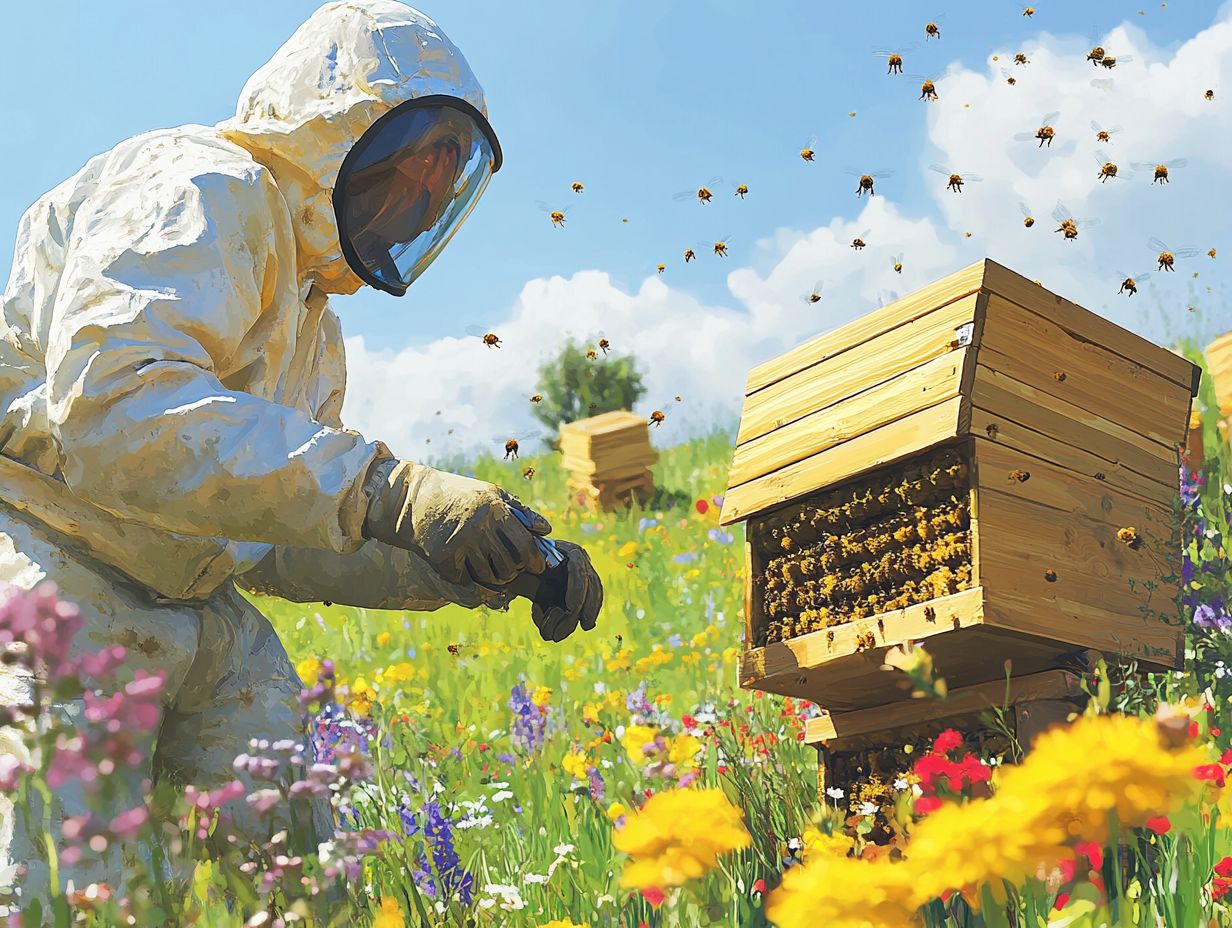
Rotating hive boxes within your multi-colony apiary can significantly enhance hive management. This ensures that your bees enjoy equal access to foraging opportunities and resources. By periodically swapping the positions of your hive boxes, you can optimize brood frames and create a balanced environment for all your colonies. This not only reduces competition but also enhances overall productivity. Consider consulting Ernie Schmidt for additional insights on this practice.
This practice fosters a healthier atmosphere for your bees while encouraging them to explore new foraging areas. Ultimately, this leads to increased pollination efficiency. Rotating hive boxes also reduces the risk of diseases and pests that thrive in stagnant conditions, disrupting their lifecycle and reducing infestations.
You ll notice the effects particularly in brood frames, as an even distribution of young bees across colonies ensures a more consistent population density. As a result, you cultivate stronger hives that are better equipped to withstand environmental changes and flourish throughout the season.
Start rotating your hive boxes today for healthier bees!
3. Monitoring for Pests and Diseases
Monitoring for pests and diseases is essential in a multi-colony apiary. Threats like Varroa mites, a type of parasite that harms bees, can wreak havoc on bee populations and jeopardize the health of your hives. Conduct regular checks for signs of infestations and implement simple pest control methods to maintain robust colonies and ensure sustainable honey production.
Establish a consistent inspection schedule to catch early signs of trouble. Evaluate bee behavior regularly to catch any issues early, assess bee activity, and check for signs of pests.
Adopting preventive measures is also important. Maintaining strong colonies through proper nutrition and optimal hive placement will bolster your colonies resilience against infestations. Consider utilizing natural treatments and promoting genetic diversity within your hives.
By being proactive and responsive, you can mitigate the impact of pests like Varroa mites and contribute positively to the overall health of your ecosystem.
4. Providing Adequate Food and Water
Providing adequate food and water is crucial for the well-being of your bee colonies in a multi-colony apiary, as it directly impacts their health and productivity. Regularly monitor food supplies, especially during low nectar availability, and ensure clean water sources are easily accessible to meet the colonies’ needs. Ernie Schmidt from the Olympia Beekeeping Association emphasizes the importance of watching for nutritional needs.
This requires understanding the specific nutritional requirements of bees and being alert for signs of food depletion, such as decreased foraging activity and increased aggression. Offer supplemental feeding options, like sugar syrup or pollen substitutes, during lean times. Also, maintain clean water sources to prevent contamination and the spread of disease, creating a safe environment for your bees.
Make it a priority to provide these resources for thriving colonies! By doing so, you can significantly enhance the overall vitality of your apiary, resulting in stronger hives and improved honey production. Remember, maintaining hive health is an ongoing process, influenced by both the internal dynamics of the colonies and various external environmental factors.
What Are the Challenges of Managing a Multi-Colony Apiary?
Managing a multi-colony apiary presents unique challenges that you must skillfully navigate. This includes the heightened time and effort needed for effective colony maintenance, the ever-present risk of disease spread, and the possibility of aggressive behavior among your bees.
To tackle these challenges, it’s essential to adopt a well-informed approach to hive management, particularly regarding critical issues like Varroa control and maintaining the overall health of your colonies from a beekeeper’s perspective. Start your regular inspections today to ensure the health of your hives!
1. Increased Time and Effort
One of the primary challenges you ll face while managing a multi-colony apiary is the increased time and effort it demands. Regular inspections, pest monitoring, and ensuring that each colony has sufficient resources can be quite a commitment.
Yet, this dedication offers valuable learning opportunities that will enhance your skills and knowledge in hive management.
As you navigate the complexities of handling multiple colonies, you ll encounter a variety of scenarios that deepen your understanding of bee behavior and health. Each colony presents its own unique challenges ranging from different levels of honey production to varying susceptibility to diseases requiring you to adapt your strategies accordingly.
Different hive types, such as the Langstroth hive, Warre hive, and Top Bar hive, offer various benefits and challenges that you must consider when managing your apiary.
This journey will sharpen your critical thinking skills and keep you on your toes!
Collaborating with fellow beekeepers, such as those from the Olympia Beekeeping Association, to exchange insights about different colonies can reveal innovative techniques and best practices that you might not discover in a single-colony setup.
Ultimately, the demanding nature of multi-colony management serves as a powerful catalyst for both your personal and professional growth throughout your beekeeping journey.
Learning from experts such as Ernie Schmidt, Paul Horton, F.E. Moeller, and CL Farrar can significantly enhance your knowledge and skills.
2. Potential for Disease Spread
The potential for disease spread among colonies is a significant concern in a multi-colony apiary. Illnesses can easily transfer from one hive to another, jeopardizing the overall health of your apiary.
Implementing effective Varroa control and regularly monitoring for signs of disease are critical practices you need to adopt to mitigate this risk and maintain healthy colonies.
Effective Varroa control involves monitoring and managing Varroa mites, tiny parasites that harm bees, which are significant vectors for various bee diseases.
Along with these measures, you should prioritize establishing a robust biosecurity protocol that includes minimizing hive movement between locations and ensuring that your equipment is sanitized before use.
Educating yourself about common diseases such as American foulbrood and nosema can further enhance your apiary’s resilience.
Timely interventions, like requeening or utilizing pathogen-resistant bee strains, can also play a vital role in preserving the integrity of your hives.
By cultivating a proactive approach to hive management, you can significantly reduce the likelihood of disease propagation, ensuring a thriving and productive environment for your bees.
3. Potential for Aggressive Behavior
In a multi-colony apiary, you may encounter challenges stemming from aggressive behavior among colonies, especially during peak foraging times or when they feel threatened.
Understanding bee behavior and implementing effective hive management techniques can help you mitigate aggression and foster a harmonious environment within your apiary.
Several factors contribute to this aggression, including the genetics of the bee variety, environmental stressors like inadequate forage or extreme weather conditions, and insufficient space within the hives.
To reduce stress, consider strategies such as ensuring ample food sources and maintaining proper ventilation in your hives.
Regular inspections to monitor the health of your colonies, combined with a calm approach during hive management, can significantly decrease the likelihood of confrontations.
Utilizing hive designs such as the Cheshire plain can also aid in managing colony behavior.
Furthermore, utilize barriers between colonies to enhance tranquility, relocating an aggressive hive if necessary to create a more productive beekeeping experience.
Frequently Asked Questions
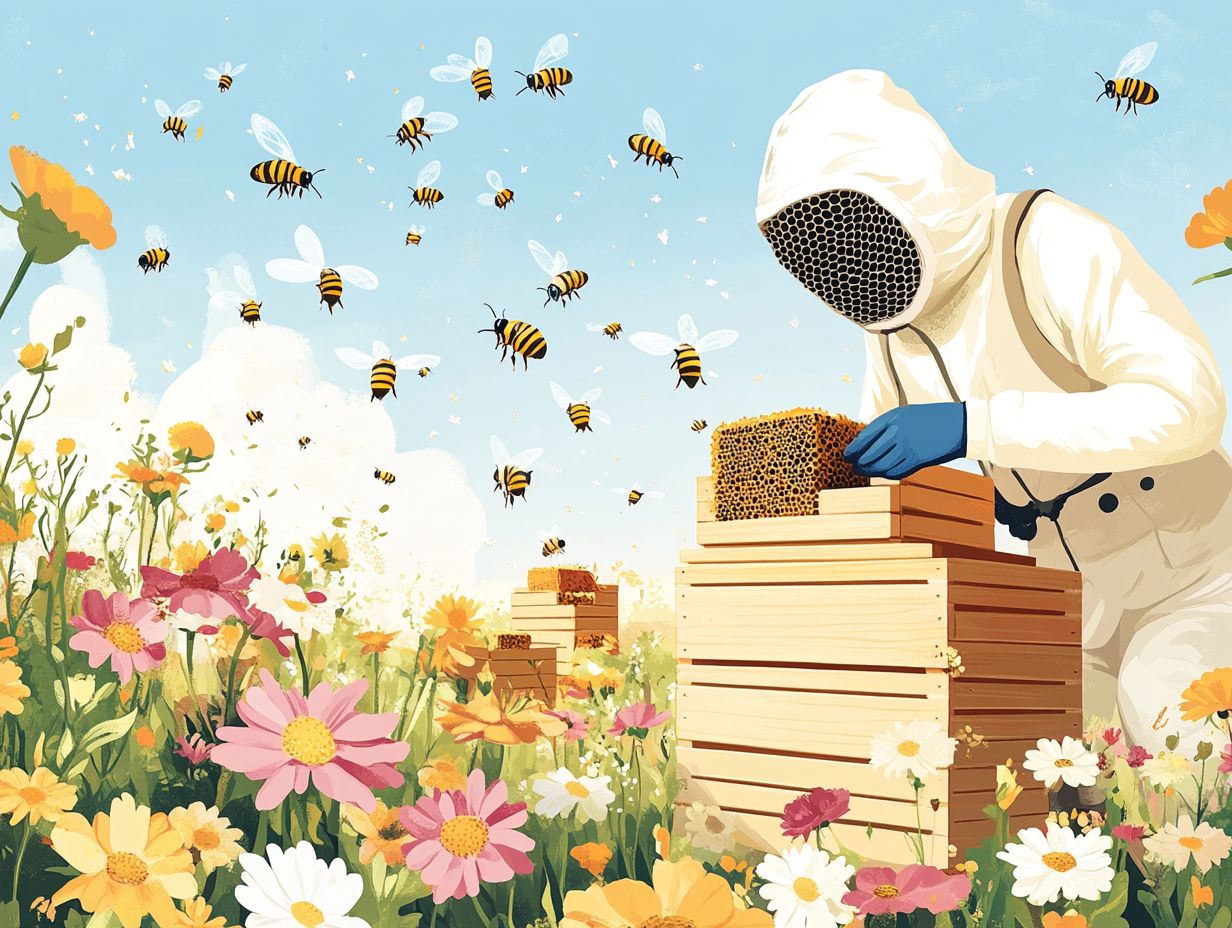
Embrace the challenges of multi-colony beekeeping today, and watch your skills flourish!
1. What is a multi-colony apiary and why is it important to manage it properly?
A multi-colony apiary is a beekeeping operation that consists of multiple colonies of bees. It is important to manage it properly to ensure the health and productivity of the bees, as well as the overall success of the apiary. Different hive designs, like the Cheshire plain, can also impact hive management strategies.
2. How often should I inspect my multi-colony apiary and what should I look for?
You should inspect your multi-colony apiary at least once every two weeks during the active beekeeping season. During these inspections, look for signs of disease, pests, and any issues with the colony’s health or productivity.
3. How can I prevent swarming in a multi-colony apiary?
To prevent swarming, regularly check for signs of overcrowding, provide enough space for the bees to expand, and replace old or damaged combs. You can also use swarm control techniques, such as splitting the colony or using queen excluders.
4. How do I manage honey production in a multi-colony apiary?
To manage honey production, monitor the honey stores in each colony and ensure they have enough space to store honey. Add supers (boxes) when necessary and harvest honey at the appropriate time, following local regulations.
5. How do I keep track of the different colonies in a multi-colony apiary?
You can keep track of your colonies by labeling each hive with a unique number or symbol and maintaining detailed records of their health, productivity, and any treatments or interventions you have performed. Consider using a hive inspection app or notebook to track your observations for each colony.
6. What should I do if one of my colonies is struggling or fails?
If one of your colonies is struggling, it is important to identify the cause and take appropriate action. This could include providing extra food, treating for pests or diseases, or re-queening the colony. If a colony fails, thoroughly clean and sterilize the hive and equipment before introducing new bees.



